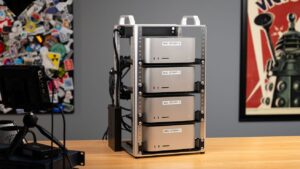
Nuclear energy is experiencing a resurgence, with a focus on small modular reactors (SMRs) that promise to reshape the global energy landscape. As demand for electricity surges, driven in part by artificial intelligence advancements, these compact reactors are gaining traction among major corporations seeking reliable, carbon-free power. Notably, significant developments are expected throughout 2025, with leading stakeholders like NuScale Power, Amazon, and Terrestrial Energy making substantial commitments to this evolving sector.
The appeal of SMRs lies in their scalability, flexibility in siting, and potential to provide dedicated baseload power. This shift is not merely theoretical; it is manifesting through billion-dollar projects that signal a move from niche applications to mainstream energy solutions. For instance, in early September 2025, NuScale Power announced a groundbreaking partnership with the Tennessee Valley Authority (TVA) and ENTRA1 Energy, aiming to deploy up to 6 gigawatts of SMR technology within the TVA service area. This commitment marks the largest SMR initiative in U.S. history.
The structure of this agreement is noteworthy. Rather than placing the full regulatory and financial burden on TVA, ENTRA1 will finance, own, and operate the facilities, selling power back to TVA through a long-term Power Purchase Agreement. This innovative financing model could facilitate institutional investment, transitioning SMRs from demonstration projects to viable, utility-scale assets.
Industrial Heat and Market Strategies
The race to develop SMRs extends beyond electricity generation; it’s also about addressing the industrial heat market, which constitutes roughly 20% of global energy demand, according to the Clean Energy Forum. Terrestrial Energy is targeting this opportunity with its Integral Molten Salt Reactor, a Generation IV design that utilizes molten salt as both coolant and fuel. This technology is particularly effective for producing clean hydrogen and synthetic fuels.
In October 2025, Terrestrial Energy completed a merger with HCM II Acquisition Corp., raising approximately $293 million to support its U.S. licensing and construction efforts. The company plans to focus solely on the U.S. market, commencing with its first commercial project at the Texas A&M RELLIS Campus. If successful, this molten-salt design could complement light-water SMRs by supplying the continuous, zero-carbon thermal energy essential for factories and chemical plants.
As the energy landscape evolves, large corporations like Amazon are also stepping into the role of energy developers. In October, Amazon unveiled plans for the Cascade Advanced Energy Facility near Richland, Washington, in collaboration with Energy Northwest. This facility will utilize X-energy‘s Xe-100 SMRs, starting with a capacity of 320 MW and potentially scaling to 960 MW. By investing in its own baseload generation, Amazon is illustrating a new model for corporate energy resilience, particularly in the context of data centers that demand high-density, continuous power.
Challenges Ahead in SMR Deployment
Despite the burgeoning interest in SMRs, the sector faces significant challenges that could hinder progress. First and foremost is the execution risk associated with transitioning from prototype to production. The experience of Georgia’s Vogtle expansion, which saw significant delays and cost overruns, serves as a cautionary tale for the industry. While SMRs are designed to mitigate such risks through standardization and factory manufacturing, the proof of these efficiencies remains to be demonstrated.
Another obstacle lies in supply chain maturity. The precision components and advanced fuels required for nuclear construction necessitate a robust manufacturing base, which has contracted over the years. As U.S. developers compete for limited capacity in crucial materials, the industry must work to rebuild this infrastructure.
The regulatory environment also poses challenges, with the U.S. Nuclear Regulatory Commission having made strides in modernizing processes, yet still facing lengthy licensing and environmental review periods. Additionally, the lack of harmonized licensing standards globally can impede the scaling of SMR technologies across different markets.
Financing structures will play a critical role in determining the success of SMR projects. Emerging models, such as “nuclear-as-a-service” from ENTRA1, could shift early-stage risk away from utilities, but sustained investor confidence relies on reliable policy support and successful project execution.
The nuclear industry remains under intense scrutiny. If initial SMR projects falter, momentum towards nuclear resurgence could diminish rapidly. Conversely, successful completion of these projects could lead to a rebirth of nuclear power as a scalable, clean, and commercially viable energy source.
As the SMR sector approaches a pivotal moment, the focus is shifting from whether these reactors will become integral to the energy mix to how quickly they can be constructed and who will lead the charge. The next decade will be crucial in determining whether SMRs can bridge the gap between clean energy ambitions and industrial realities.






